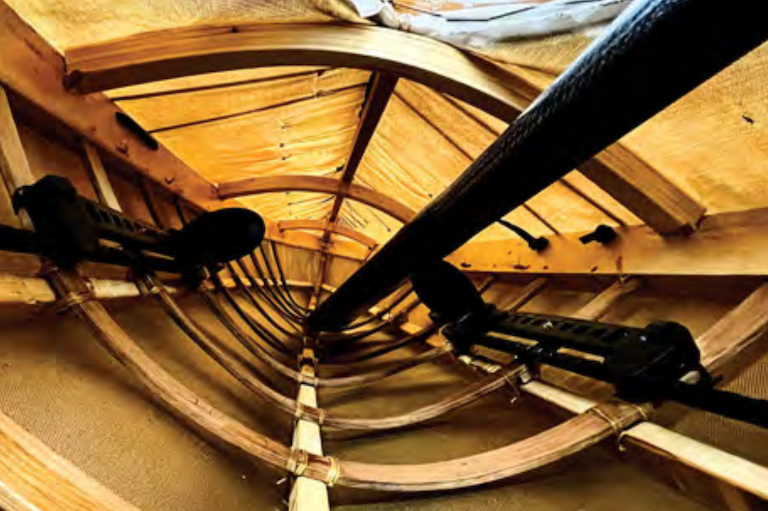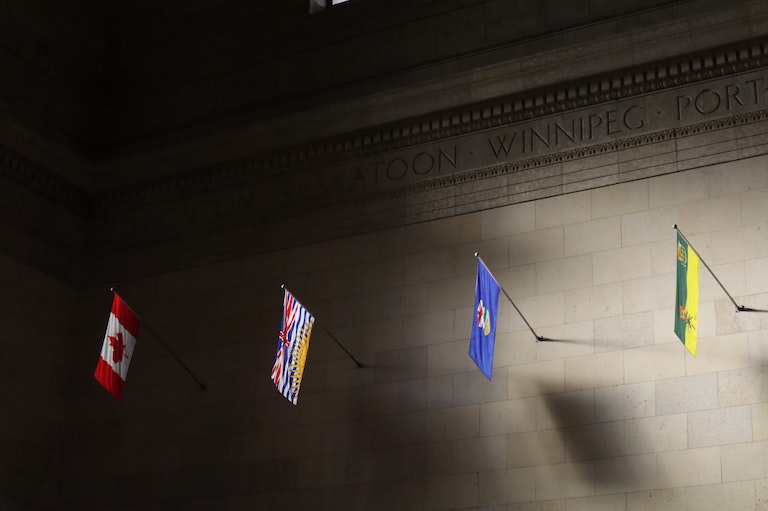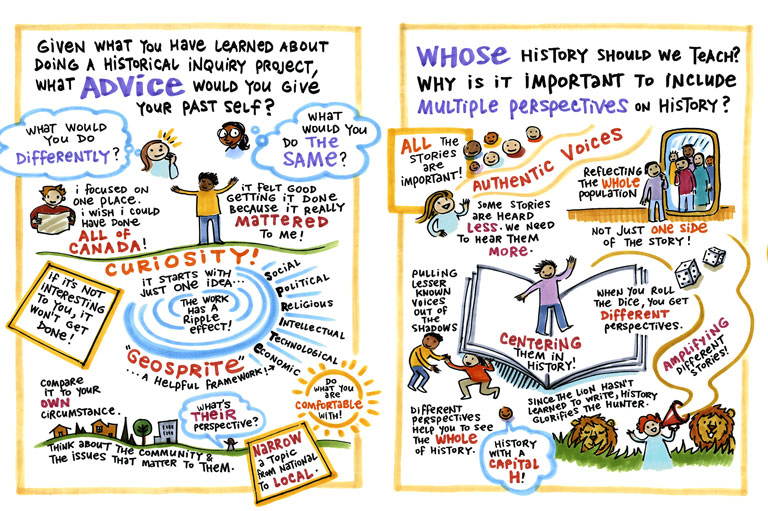The Use of Media in Exploring Afro Indigenous Ancestry
Grade Levels: 5/6, 7/8
Subject Area: Social Studies, History, ELA
This lesson is based on the article “Black and Indigenous” in the expanded (2022) Black history in Canada issue of Kayak: Canada’s History Magazine for Kids.
Lesson Overview
This lesson will ask students to use creative, academic, and observational skills to define terms which are important to understanding Afro Indigenous ancestry and to reflect on how media has been used over time to express important ideas about justice and ethnicity. Students will discuss what they have learned about Afro Indigenous cultural expression and demonstrate their learning by using several vocabulary words in a post using the format of modern media. In the extension activity, students will make comparisons between modern media styles and older uses of media.
Historical Thinking Concept(s)
- Establish historical significance
- Use primary source evidence
- Identify continuity and change
- Analyze cause and consequence
- Take historical perspectives
- Understand the ethical dimension of historical interpretations
Learning Outcomes
Students will:
- Define and describe terms in a vocabulary list.
- Investigate, evaluate, and discuss topics related to Afro Indigenous cultures and ethnicities.
- Investigate and evaluate how various forms of digital media are used to create awareness.
- Design and create a media post that demonstrates their understanding of the vocabulary words and their understanding of how media content can spread awareness of social issues. This can be an imagined post, created digitally or on paper.
Background Information
People with a mixed heritage consisting of the Indigenous Nations of Turtle Island and African ancestry have existed in Canada for centuries. The origins of some of these lineages can be traced to the transatlantic slave trade and even before. Enslaved Africans who were brought to North America later integrated and intermarried into various Indigenous nations.
Additionally, many enslaved Africans who escaped were welcomed freely into Indigenous nations. Even before the slave trade, historical evidence suggests African people made contact with Indigenous people.
Digital platforms and digital media have been used for years to advertise, spread messages, and influence the public. Most of all, many people use digital media to express themselves, their knowledge, their creativity, and the issues that are closest to their communities. Because of this, recently there has been increased support for social issues through these platforms.
The Proclaiming Our Roots project uses digital storytelling to provide an outlet for Afro Indigenous people to express their identities creatively. Keisha (@wapahkesis on Instagram) uses Instagram to create digital content that spreads awareness about the beauty of the Afro Indigenous identity and some of the social justice issues that greatly affect people’s quality of life.
In this lesson, the concepts of Afro Indigenous identity awareness blend with the power of digital media platforms to teach students about the existence of rich and unique ethnic groups all over Canada.
Lesson Activity
PART 1:
- As a class, discuss the concept of blending ethnicity and culture via individuals with mixed ancestry. Introduce the Afro Indigenous identity in Canada.
- Explain in detail the history of how African Canadians came to Canada around the time of the transatlantic slave trade (and prior).
- Highlight various Indigenous nations that have existed in Canada for centuries (their territory, their language, key elements of their cultures, etc.).
- Present 10 vocabulary words to students and give them time to use a dictionary and the internet to define the terms. Before moving on to other content, be sure to present students with the proper definitions of the terms and allow them to confirm that they have the correct responses.
- Read the article “Black and Indigenous” by Oscar Baker III. You may opt to read the text to students as they follow along with their own copy of the text. Creating a glossary of terms before the students read the text will help them better understand the context and meaning of the words being used.
- Allow students to process what they have read and give them time to discuss with their classmates as partners or in small groups. After a brief discussion in small groups or partners, come together and discuss the text as a class.
- Guiding Questions: How did people of African ancestry become linked with certain Indigenous nations? Is there anything these two groups may have in common as “Freedom-Seekers”?
- As a class, explore the Proclaiming Our Roots website. Reading the “About” section will allow students to gain an understanding of the premise of the project. Show a video from the project to allow students to hear a first-person narrative about exploring an Afro Indigenous ethnicity. Discuss how the website and the project help spread awareness about Afro Indigenous identity and some of the social issues individuals may face in Canada.
- Guiding Questions: Does digital media help make these stories more interesting? How so? What are some common issues raised in the videos made by Afro Indigenous people in the Proclaiming Our Roots project?
- As a class, explore two short Instagram Reels created by Keisha (a participant of the Proclaiming Our Roots project). Keisha’s videos demonstrate how she spreads awareness of social issues that affect her as an Afro Indigenous person. She has extended her involvement in spreading awareness beyond the Proclaiming Our Roots platform and is using other forms of digital media to spread her message and to influence the public.
- Allow students to reflect on and speak about what is being said and what it means to influence an audience. As a group, discuss the videos and their impact.
- Guiding Questions: How does Keisha use her digital platform creatively to spread information about Afro Indigenous identity (creative choices, images used, actions shown, language used, etc.)? What are some important issues raised by Keisha in her videos?
PART 2:
- Students will be asked to design a creative short form media post, such as one that would be on Instagram, Facebook, or on a blog.
- The media post must consist of at least two of the vocabulary words and must spread awareness about at least one the issues or topics discussed in relation to Afro Indigenous identity.
- The post can consist of a statement about Afro Indigenous identity in one to three sentences (in written or video form), or it could consist of an artistic piece such as a drawing that demonstrates an issue or quality relative to Afro Indigenous identity.
- Included in the media post, students should write a descriptive caption that further expands on the concept presented in their post. Their descriptive caption should be no more than 150 words, use at least 4-5 of the vocabulary words, and demonstrate their understanding of the existence of Afro Indigenous identity in Canada. It should describe the concept or idea that is being presented and the importance of spreading awareness about this topic. Students can also include how they were inspired to create their post and their creative process as part of the caption.
- Teachers may ask students to share their finished products with the entire class.
Materials/Resources
- “Black and Indigenous” article in the expanded (2022) Black History in Canada issue of Kayak
- Vocabulary Words
- Proclaiming Our Roots
- Sam’Gwan’s Song (YouTube)
- Sierra’s Story - INTRSCTNL (YouTube)
- Keisha’s Instagram Content (Reel #1)
- Keisha’s Instagram Content (Reel #2)
Vocabulary Words
Afro-Indigenous: An ethnic group consisting of people of mixed Indigenous (of Turtle Island) and African ancestry.
Refuge: A condition of being safe or sheltered from pursuit, danger, or trouble.
Freedom-Seekers: Individuals seeking freedom from oppression, slavery, and injustice.
Mi’kma’ki: Mi’kma’ki is the traditional territory of the Mi’kmaq and includes seven districts which are found in what is now known as Nova Scotia, Prince Edward Island, New Brunswick, Newfoundland and Labrador, and the Gaspe region in Quebec (HRCE).
Anishinaabe: Anishinaabe (other variants include Anishinabe, Anicinape, Nishnaabe, Neshnabé and Anishinabek) refers to a group of culturally and linguistically related First Nations that live in both Canada and the United States, concentrated around the Great Lakes. The Anishinaabeg (plural form of Anishinaabe) live from the Ottawa River Valley west across Northern Ontario and to the plains of Saskatchewan south to the northeast corner of North Dakota, northern Minnesota and Michigan, as well as the northern shores of Lakes Ontario and Erie. The Ojibwe, Chippewa, Odawa, Potawatomi, Algonquin, Saulteaux, Nipissing and Mississauga First Nations are Anishinaabeg (www.thecanadianencyclopedia.ca).
Haudenosaunee: The Haudenosaunee, or “people of the longhouse,” commonly referred to as Iroquois or Six Nations, are members of a confederacy of Indigenous nations known as the Haudenosaunee Confederacy. Originally a confederacy of five nations inhabiting the northern part of New York state, the Haudenosaunee consisted of the Seneca, Cayuga, Oneida, Onondaga and Mohawk (www.thecanadianencyclopedia.ca).
Lineage: A social group tracing its ancestry from a single ancestor or bloodline.
Black Seminoles: The Black Seminoles are descendants of runaway slaves who escaped from coastal South Carolina and Georgia into the Florida wilderness beginning as early as the late 1600s. The runaway slaves joined with various Native American groups escaping into Florida at the same period. Together, the two groups formed the Seminole tribe, a multi-ethnic and bi-racial alliance (McGill University).
L’nu: The word “L’nu” means the people of the same tongue and is the preferred name of the tribe otherwise known as Mi’kmaq. L’nu is singular and L’nuk is plural (Policy Options.org).
Anti-Blackness: A form of racism and oppression that affects Black people (people of African ancestry) systemically, structurally, and interpersonally.
Proclaim: Announce officially or publicly.
Intermarried: People belonging to different ethnic, religious, or social groups becoming connected by marriage.
Ethnicity: The quality or fact of belonging to a population group or subgroup made up of people who share a common cultural background or ancestry.
Identity: The distinguishing characteristics of an individual or group. The qualities, beliefs, etc. that make a particular person or group distinct from others (Merriam Webster).
Influence: The power to change or affect someone or something: the power to cause changes without directly forcing them to happen.
Cree: The Cree or Nehiyawak (neh-HEE-oh-wuk) in the Cree language, are the most populous and widely distributed Indigenous peoples in Canada. Cree First Nations occupy territory in the Subarctic region from Alberta to Quebec, as well as portions of the Plains region in Alberta and Saskatchewan (www.thecanadianencyclopedia.ca).
Black Loyalist: The largest group of people of African ancestry ever to migrate to Nova Scotia as a single group. As many as 3500 Black Loyalists arrived in Nova Scotia between 1783 and 1785 (Black Cultural Center of NS).
Extension Activity
The above activity focuses heavily on the way digital media can be used to spread awareness about issues that affect Afro Indigenous people. But before digital media existed, print media was used to spread information and awareness. African Nova Scotian entrepreneur, human rights activist, author, journalist, publisher, and trail blazer Carrie Best was among the first African Nova Scotians to found, own, and publish a newspaper. Carrie Best’s newspaper, The Clarion, was one of the first newspapers in Nova Scotia owned and published by a Black Canadian. Carrie Best used the platform to advocate for civil rights and to speak against Anti-Black racism. She is notable in spreading awareness and supporting Viola Desmond in her case against the Roseland Theatre.
Activity:
- Have students read about Carrie Best and watch the video about modern efforts to honour and remember her legacy.
- Ask students to draw comparisons between modern digital methods of mass media and older methods of mass media such as printable text. Students may explore the pros and cons of each type of media in terms of reach, longevity, and accessibility. Students may be asked to draw comparisons between the work of Carrie Best and the work of the Proclaiming Our Roots project and the content creator and activist Keisha.
For the Extension Activity:
- Carrie Best (The Canadian Encyclopedia)
- “How journalist Carrie Best gave the Black community a voice when it didn’t have one | Your Morning,” YouTube
- Celebrating Carrie Best (Google Doodle)
Themes associated with this article
Advertisement




